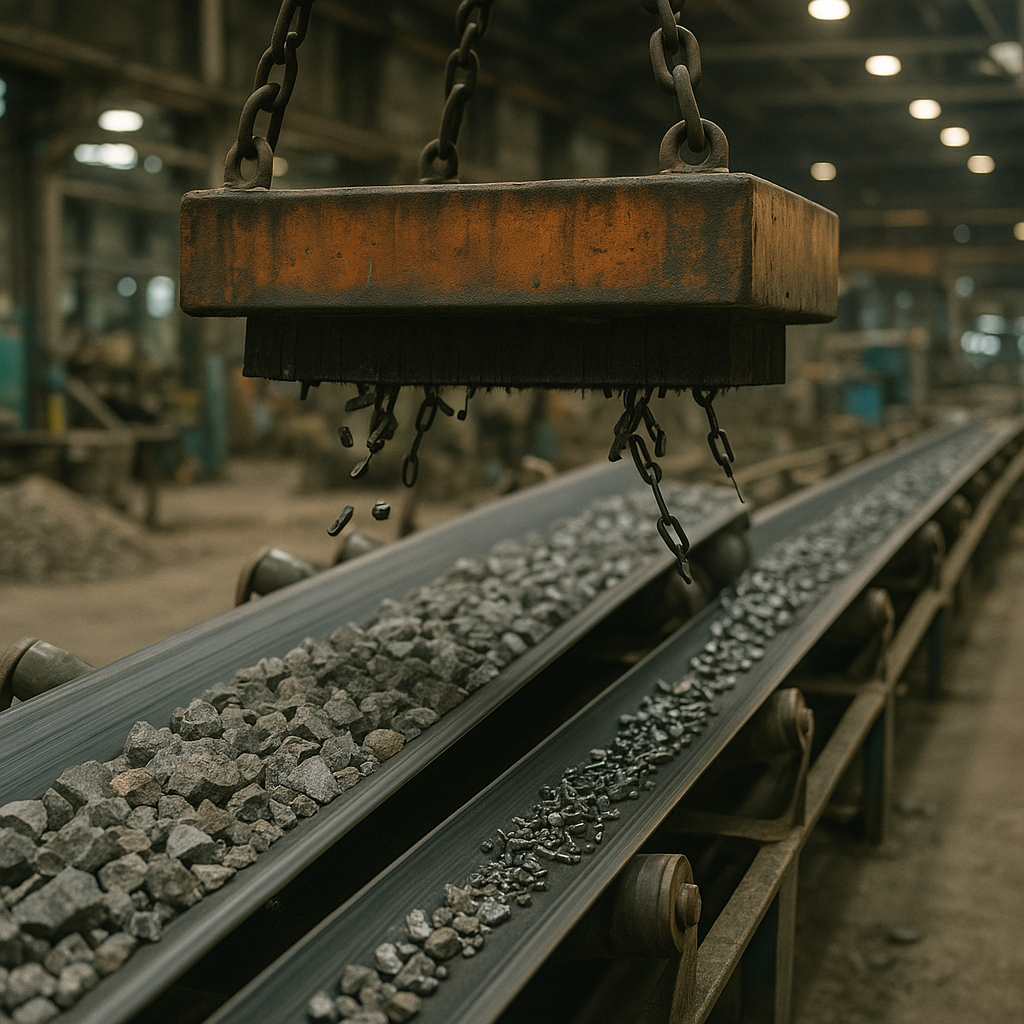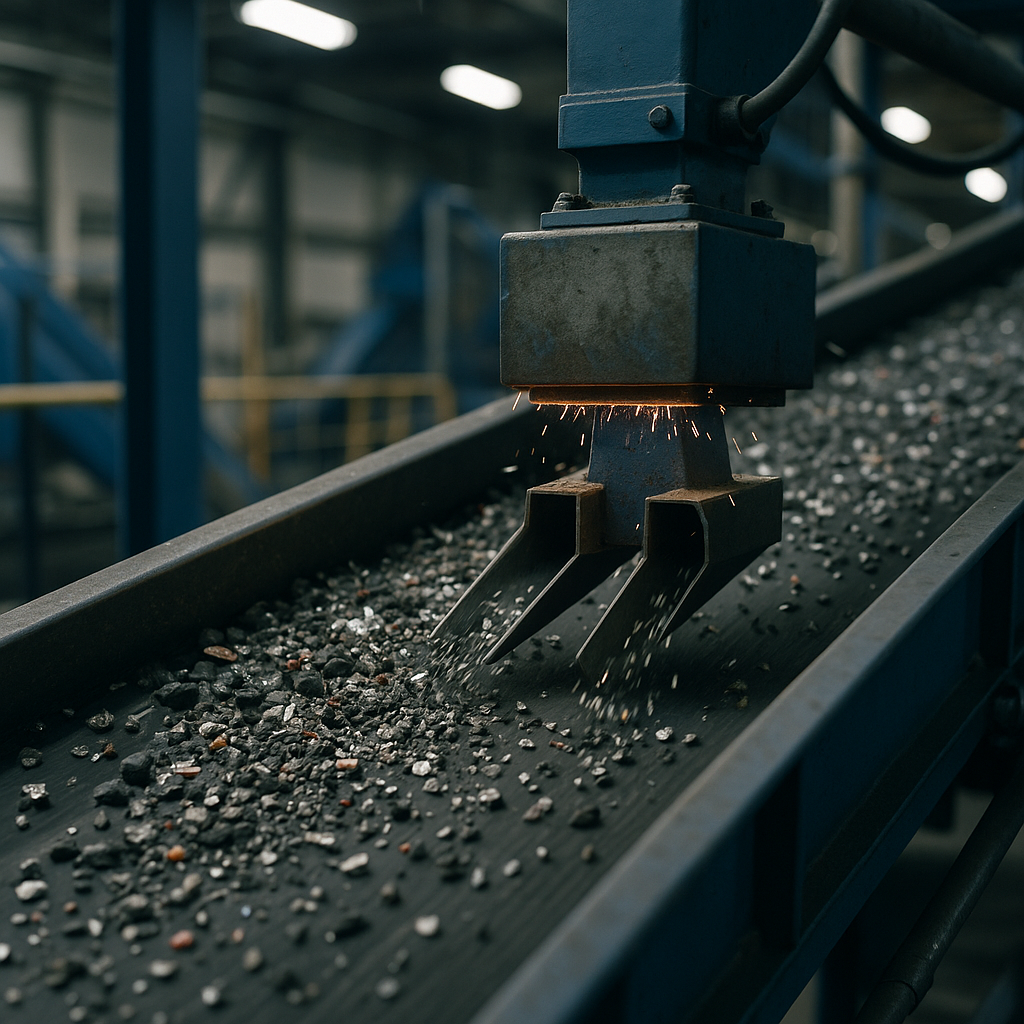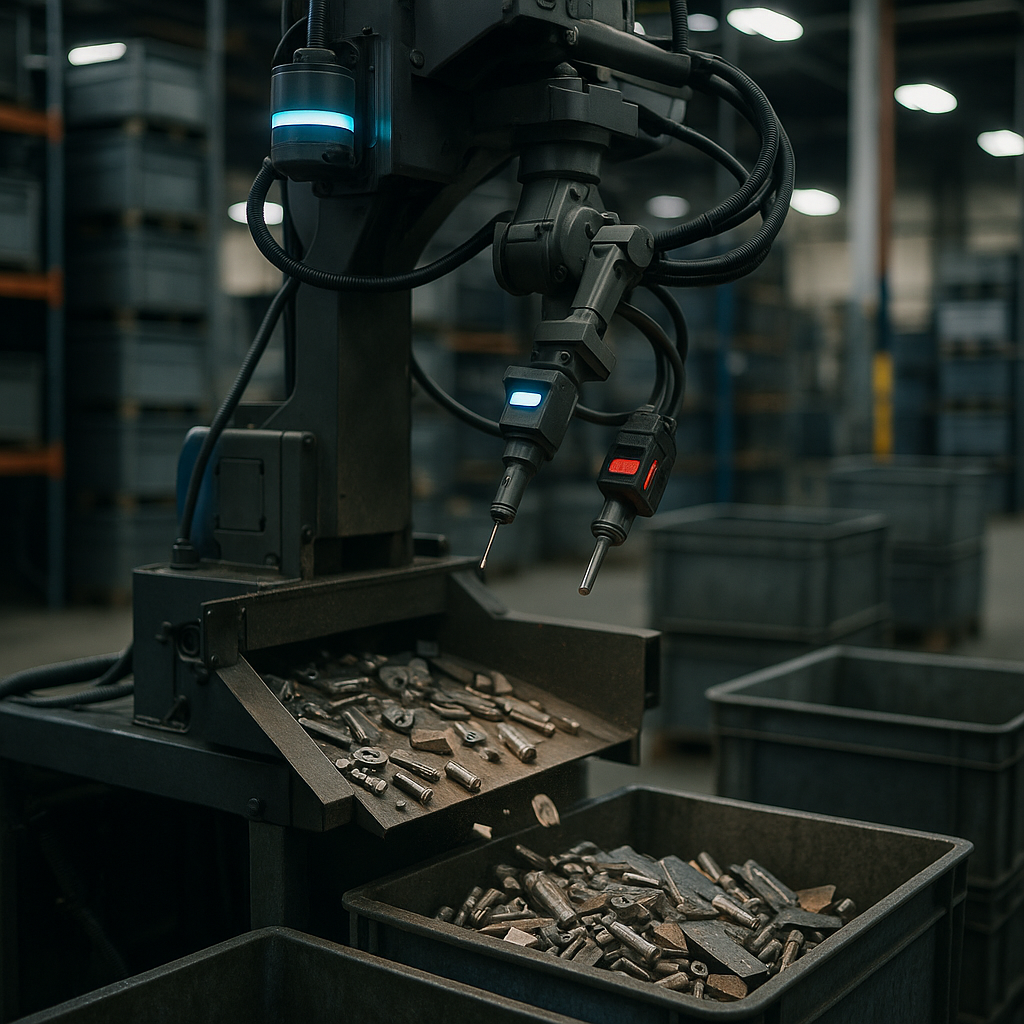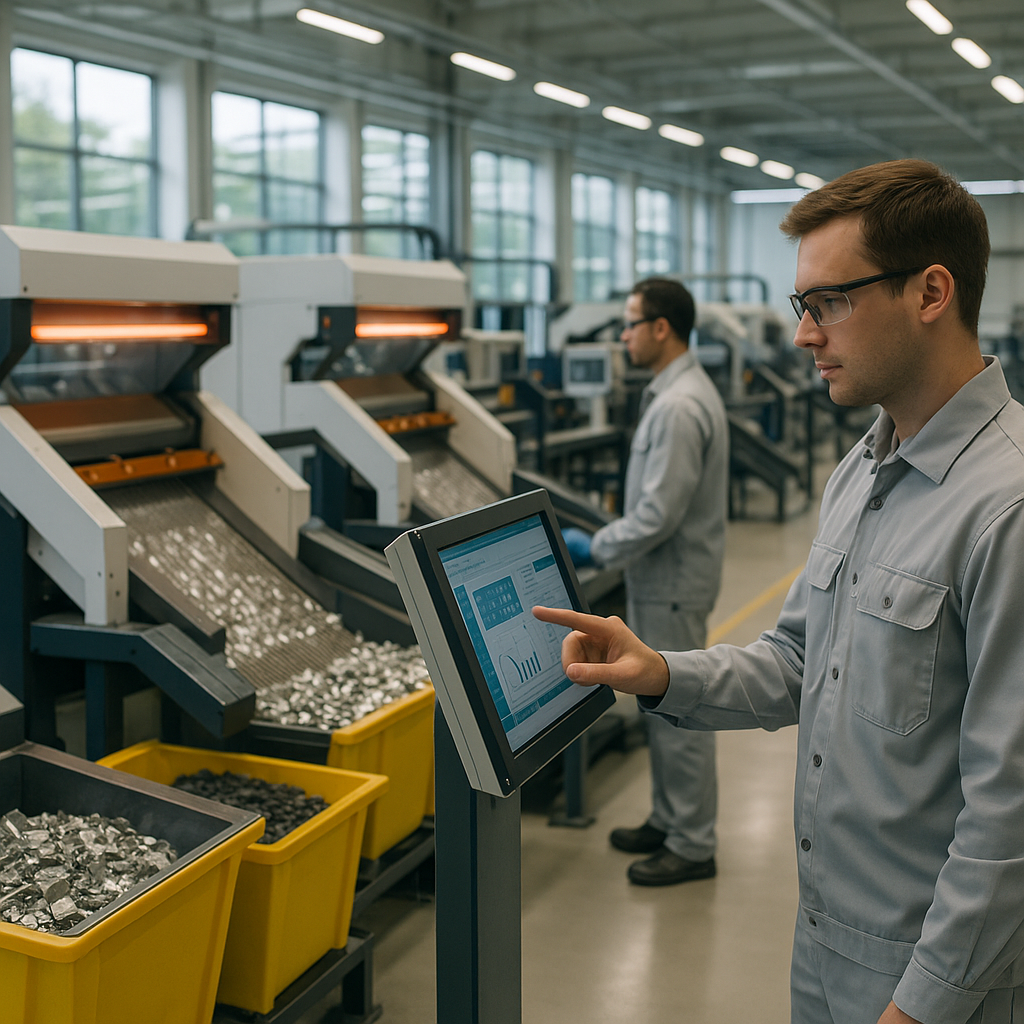5901 Botham Jean Blvd, Dallas, TX 75215
What Are Advanced Metal Separation Technologies?
September 29, 2025In our resource-conscious era, metal recovery is more crucial than ever. Advanced metal separation technologies offer innovative methods to efficiently extract and recover valuable metals from waste streams and raw materials, significantly outperforming conventional techniques in both precision and effectiveness.
The metal recycling landscape has been transformed by several key technologies. Magnetic separation employs powerful magnetic fields to capture ferrous metals with remarkable accuracy. Electrostatic separation uses electrical charges to sort conductive from non-conductive materials, while sensor-based sorting utilizes sophisticated detection systems to identify metals based on their unique properties.
Advanced membrane filtration, another groundbreaking technology, enables the separation of metals at molecular levels. These technologies offer common advantages: improved recovery rates, enhanced metal purity, reduced energy consumption, and significantly lower environmental impact. The metal recycling industry continues to adopt these methods to meet the growing demands for resource conservation and sustainability compliance.
How Do Magnetic Separation Technologies Work?

Magnetic separation technology relies on the attraction between magnetic fields and ferrous (iron-containing) materials. When waste materials pass through or near a magnetic field, magnetic items are drawn towards the magnets, while non-magnetic materials continue unaffected. This phenomenon allows for efficient sorting of mixed materials without complex chemical processes.
In recycling facilities, magnetic separators create controlled magnetic fields to extract ferrous metals like steel and iron from mixed waste streams. These systems use either permanent magnets or electromagnets to generate the necessary magnetic force. Magnetic separation occurs at strategic points in the recycling process, typically after initial sorting but before materials enter crushers or shredders.
Types of Magnetic Separators
Various magnetic separation systems are designed to handle different materials and processing needs:
Drum magnets use cylindrical rotating shells containing fixed magnets. As mixed materials flow over the drum, magnetic particles adhere to the surface and are carried to a collection point. These systems are effective for processing high volumes of material in continuous operations.
Overband magnets suspend above conveyor belts to pull ferrous metals upward from the mixed stream. The captured materials are then diverted to a separate collection area. This method is effective for removing larger ferrous contaminants before they enter crushing equipment.
Magnetic pulleys replace standard conveyor head pulleys with magnetic versions. As materials reach the end of the conveyor, magnetic items cling to the belt longer and fall into a different collection bin than non-magnetic materials. These systems integrate seamlessly into existing conveyor setups.
| Type of Separator | Application | Industries |
|---|---|---|
| Drum Magnets | Separate ferrous metals from large volumes of materials | Mining, Recycling |
| Overband Magnets | Remove larger ferrous contaminants from mixed streams | Recycling, Municipal Waste Management |
| Magnetic Pulleys | Extract ferrous materials from conveyor belts | Recycling, Manufacturing |
| High-Gradient Magnetic Separators (HGMS) | Recover weakly magnetic materials | Mining, Mineral Processing |
| Rare Earth Magnetic Separators | Extract fine ferrous particles | Separation Operations, Metal Purity Enhancement |
| Eddy Current Separators | Recover non-ferrous metals like aluminum and copper | Recycling |
Advancements in Magnetic Separation Technology
Recent innovations have significantly expanded magnetic separation capabilities. High-gradient magnetic separators (HGMS) create intensified magnetic fields with steep gradients, enabling the capture of weakly magnetic (paramagnetic) materials that traditional systems would miss. This technology opens new possibilities for recovering valuable minerals and metals.
Rare earth magnetic separators utilize neodymium magnets that generate exceptionally strong magnetic fields. These systems can extract even fine ferrous particles from material streams, providing more precise separation of materials with varying magnetic susceptibilities.
Eddy current separators are another advancement, specifically designed for non-ferrous metal recovery. These systems use rapidly rotating magnetic rotors to induce electric currents in non-ferrous metals like aluminum, copper, and brass. This generates a magnetic field that repels these metals from the waste stream, enabling their recovery.
Applications Across Industries
Magnetic separation technology serves critical functions across multiple sectors:
In municipal recycling, magnetic separators extract steel cans and other ferrous items from household waste. This process recovers valuable metals and prevents metal contaminants from damaging downstream equipment.
Mining operations use magnetic separation to concentrate valuable minerals from ore. For example, magnetite (iron ore) can be efficiently separated from surrounding rock using magnetic systems, significantly reducing processing costs.
Food processing facilities employ magnetic separators to remove metal fragments that may contaminate food products during manufacturing, providing essential safety checks before packaging.
Industrial manufacturers use magnetic separation to purify raw materials and recover valuable metals from production waste, improving product quality while supporting sustainability goals through material recovery.
Construction and demolition recycling operations rely on magnetic separation to extract rebar and other ferrous materials from concrete debris. This process enables effective recycling of both concrete and metal components.
What Role Does Electrostatic Separation Play?

Electrostatic separation is one of the most effective methods for sorting materials based on their electrical conductivity. This technology applies an electric field to a mixture of particles, causing them to acquire varying charges. As a result, materials follow distinct paths depending on their interaction with the field, enabling precise sorting.
This process excels at separating fine particles, typically smaller than 1mm, where traditional mechanical methods are less effective. Similar to how a balloon rubbed against hair attracts small paper pieces, electrostatic separators create environments where materials are drawn or repelled based on their electrical properties.
Recently, two innovative systems have advanced this technology:
Corona Electrostatic Separators
These systems use a high-voltage electrode to create a corona discharge that bombards particles with ions. Conductive materials like metals quickly lose their charge to a grounded roller and fall off, whereas non-conductive materials like plastics retain their charge until brushed off. This enables clean separation of different materials.
The roll-type corona-electrostatic separator is particularly valuable in recycling printed circuit boards (PCBs). Operating with voltages between 20 and 30 kV, these systems can efficiently process crushed electronic waste and extract valuable metals with high precision.
Triboelectric Separators
Triboelectric separation relies on differences in electronic surface structures between materials. When particles collide or rub against surfaces, they exchange electrons. Materials with lower work functions gain a positive charge, while those with higher work functions gain a negative charge. In an electric field, these oppositely charged particles move toward different electrodes.
This technology effectively separates materials with similar physical traits but different electrical properties—a common challenge in e-waste processing.
The significance of electrostatic separation grows as the electronic waste crisis intensifies. With global e-waste increasing by 3–5% annually and only about 30% processed through regulated channels, these technologies provide environmentally sound alternatives to hazardous disposal methods.
For industrial mineral purification, electrostatic separation achieves exceptional results in processing minerals like zircon, rutile, ilmenite, and monazite from heavy beach sands. It can deliver remarkable purity levels, as demonstrated in historical applications, such as reducing ash content in German coal from 15% to approximately 1.5%.
Electrostatic separation is especially valuable due to its dry operation. In contrast to other separation technologies requiring water, these methods process materials without liquid media, reducing environmental impact and eliminating costly dewatering steps.
| Type of Separator | Principle | Applications | Advantages |
|---|---|---|---|
| Corona Electrostatic Separator | Uses high-voltage corona discharge to charge particles | Recycling printed circuit boards (PCBs), electronic waste | High precision in separating metals from waste stream |
| Triboelectric Separator | Relies on the difference in electronic surface structure between materials | e-Waste processing | Effective for separating materials with similar physical characteristics |
As manufacturing increasingly emphasizes sustainability, electrostatic separation technology continues to advance, providing efficient ways to recover valuable materials from waste and reduce reliance on raw material extraction.
How are Sensor-Based Technologies Revolutionizing Metal Separation?

Sensor-based sorting systems mark a transformative shift in metal recycling, transitioning the industry from labor-intensive manual sorting to highly efficient automated processes. These advanced systems utilize sophisticated sensors alongside powerful data processing to identify and separate metals based on their unique properties with unmatched accuracy and speed.
Traditional metal separation methods heavily relied on visual inspection and basic magnetic techniques. Modern sensor-based technologies, however, can detect subtle differences in material composition, impossible for conventional methods to discern. This precision enables recyclers to recover valuable metals from increasingly complex waste streams.
The move to automated sensor-based sorting offers numerous advantages for metal recyclers. Processing speeds have significantly increased while contamination rates have decreased. This enhancement in both efficiency and quality results in higher recovery rates of valuable metals and purer recycled materials that fetch premium prices in the market.
Core Technologies Driving the Revolution
Several key technologies form the backbone of modern sensor-based metal separation systems:
- X-ray Transmission (XRT): These systems use X-rays to penetrate materials and measure their atomic density, enabling precise separation of metals based on their unique atomic structures.
- Near-Infrared Spectroscopy (NIR): This technology examines how materials reflect infrared light, identifying different types of metals and alloys through their spectral signatures.
- Laser-Induced Breakdown Spectroscopy (LIBS): LIBS analyzers identify the elemental composition of metals, including trace contaminants, by vaporizing a tiny sample with a high-powered laser.
- X-ray Fluorescence (XRF): This non-destructive technique determines the chemical makeup of materials, allowing for the sorting of challenging alloys with remarkable precision.
- Electromagnetic Sensors: These sensors detect and sort metals based on their electrical conductivity properties, effectively separating different metal types.
Companies like TOMRA are at the forefront of these technologies, developing integrated systems capable of accurately identifying and separating different metal types, even in complex mixtures. Their sensor-based sorting solutions have demonstrated particular promise in recovering high-purity aluminum and other non-ferrous metals from industrial scrap.
Real-World Applications and Impact
In aluminum recycling facilities, sensor-based sorting technologies are transforming operations. Modern systems can now analyze the visual characteristics of materials with unparalleled accuracy. Utilizing high-resolution cameras and sophisticated sensors, these systems efficiently categorize metals based on their spectral signatures, shapes, and textures.
The impact extends beyond aluminum to the broader scrap metal industry. Advanced optical sorting systems with AI algorithms can distinguish between different grades of copper, brass, steel, and other valuable metals. This capability enables recycling facilities to recover materials that were previously lost or downgraded in quality.
The environmental benefits are substantial. By increasing metal recovery rates and reducing the need for virgin material extraction, sensor-based sorting technologies directly contribute to resource conservation. The recycling process itself becomes more efficient, with energy consumption significantly reduced compared to processing raw materials. For example, recycling aluminum saves about 95% of the energy required for production from raw materials.
As these technologies continue to evolve, their integration with artificial intelligence and machine learning promises even greater advancements. AI-powered sorting systems can learn and adapt to variations in scrap materials over time, continuously improving separation accuracy and efficiency through ongoing data analysis.
The economic case for investing in sensor-based technologies is compelling. While the initial capital investment may be significant, improvements in recovery rates, material purity, and processing efficiency typically yield substantial returns. As these systems become more widespread, their cost will likely decrease, making them accessible to a wider range of recycling operations.
What are the Future Trends in Advanced Metal Separation?

The metal separation industry is experiencing a technological shift. As demand for metals in electronics, renewable energy infrastructure, and advanced manufacturing increases, traditional methods are being enhanced by innovations promising greater efficiency, selectivity, and sustainability.
Artificial intelligence is a transformative trend in metal separation technology. AI systems analyze vast amounts of operational data to optimize processes in real time. Unlike traditional systems with fixed parameters, AI-powered sorting equipment adapts to variations in material quality and composition. These systems employ visual pattern recognition and deep learning algorithms to identify minute differences in texture, surface properties, and composition that escape human detection.
The practical applications are already emerging. For instance, modern optical sorting systems enhanced with AI can differentiate between aluminum alloys based on subtle surface characteristics without costly chemical analysis. This enables recyclers to process materials more quickly and at reduced operational costs while achieving higher purity levels in recovered metals.
Membrane Technology Breakthroughs
Advancements in membrane technology are opening new possibilities for selective metal separation. Researchers are developing highly specialized membrane materials with precisely controlled pore sizes and surface chemistries that separate metal ions with remarkable selectivity. These next-generation membranes can distinguish between metals with similar properties, addressing a significant challenge in metal recycling.
The development of membrane inclusion polymers (MIPs) that selectively transport specific metal ions while excluding others marks a substantial advancement. These membranes combine physical filtration with chemical selectivity, permitting separation of complex metal mixtures without harsh chemicals. This method is particularly promising for recovering precious metals from electronic waste, where multiple valuable metals are present in intricate arrangements.
Nanoparticle-Enhanced Separation
Nanoparticles are emerging as powerful tools for metal separation. Functionalized nanoparticles are designed with specific surface chemistries that selectively bind to target metals. When introduced to a mixture containing various metals, these nanoparticles attach only to the desired metals, allowing for efficient separation and recovery.
The versatility of nanoparticle technology is impressive. For example, magnetic nanoparticles can be functionalized to selectively bind specific metals and then easily removed from solutions using magnetic fields. This method offers significant advantages over traditional precipitation or extraction methods, reducing chemical usage and processing steps.
Closed-Loop Systems
The industry is increasingly focusing on developing closed-loop separation systems to minimize waste and maximize resource recovery. These systems aim to recycle not just the target metals but also the separation media, reagents, and solvents used in the process. Advanced regeneration techniques allow extraction agents to be reused multiple times, significantly reducing the environmental footprint of metal separation operations.
For instance, new approaches to solvent extraction use biodegradable organic compounds that can be efficiently recovered and reused, replacing traditional petroleum-based extractants. Similarly, ion exchange resins are being designed for improved durability and regeneration capability, extending their useful life and reducing waste.
| Technology | Key Benefits | Applications |
|---|---|---|
| Magnetic Separation | Efficient separation of ferrous metals; reduces waste | Recycling of steel, iron; mining for magnetite |
| Electrostatic Separation | Effective for fine particles; no water use | E-waste processing; mineral purification |
| Sensor-based Sorting | High precision and speed; improved recovery rates | Aluminum and non-ferrous metal recycling |
| Membrane Technology | Selective ion separation; low energy consumption | Recovery of precious metals from e-waste |
| Nanoparticle Technology | Targeted metal binding; reduced chemical usage | Separation of specific metals in mixed streams |
| Closed-Loop Systems | Minimized waste; maximized resource recovery | Recycling operations across various industries |
| Sustainability-driven Innovations | Lower energy and chemical use; greener processes | Solar-powered systems; photocatalytic reduction |
Sustainability-Driven Innovation
Sustainability is driving innovation in metal separation. As industries face pressure to reduce environmental impacts, technologies that minimize energy use, eliminate toxic chemicals, and reduce waste are gaining prominence. This includes developing room-temperature separation processes that reduce energy consumption and using safer, greener reagents that replace traditional hazardous acids and oxidants used in metal leaching.
The integration of renewable energy sources into metal separation plants is also gaining momentum. Solar-powered electrowinning and electrolysis systems offer a path to recover metals with a significantly lower carbon footprint than conventional methods.
Photocatalytic reduction systems that use light energy to selectively reduce and precipitate metals from solution represent another promising development. These systems can operate with minimal chemical inputs and energy requirements, potentially transforming metal recovery economics.
The Future of Metal Separation
As these technologies mature, metal separation is expected to become more precise, efficient, and environmentally sound. The combination of AI for process optimization, advanced membranes for selective separation, nanoparticles for targeted recovery, and closed-loop systems for waste minimization will enable the industry to meet growing metal demand while reducing environmental impacts.
The future of metal separation lies in integrated systems that combine multiple technologies to address complex separation challenges. As these technologies continue to evolve, they will play a crucial role in building a more circular and sustainable metals economy.
Conclusion: The Impact of Advanced Metal Separation Technologies

Advanced metal separation technologies have fundamentally transformed resource recovery and waste management practices. These innovations enable recycling facilities to extract valuable metals with exceptional precision and efficiency. Through technologies like XRF systems, eddy current separators, and AI-powered sorting systems, the industry has significantly improved recovery rates while simultaneously reducing energy consumption and environmental impact.
These advancements bring substantial economic benefits. Metal recycling operations utilizing these technologies can recover more valuable materials from waste streams, improve product purity, and reduce processing costs. By enhancing the economic viability of metal recycling, these innovations bolster the circular economy and create sustainable jobs worldwide. Crucially, these technologies address environmental challenges by reducing the need for resource-intensive mining operations, cutting greenhouse gas emissions, and keeping hazardous materials out of landfills. For questions about implementing advanced metal separation technologies in your recycling operations, contact Okon Recycling at 214-717-4083.
